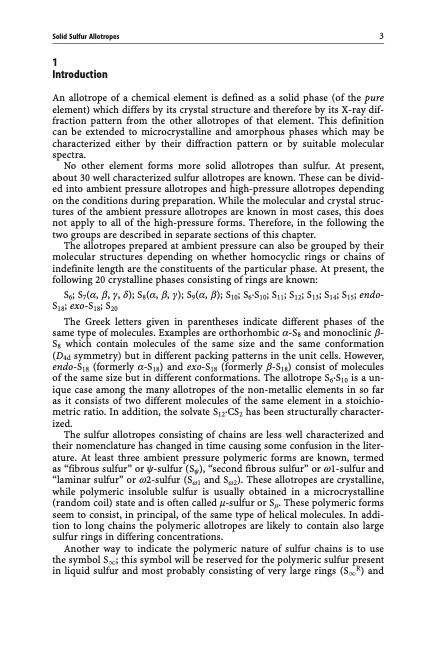
PDF Publication Title:
Text from PDF Page: 013
Solid Sulfur Allotropes 3 1 Introduction An allotrope of a chemical element is defined as a solid phase (of the pure element) which differs by its crystal structure and therefore by its X-ray dif- fraction pattern from the other allotropes of that element. This definition can be extended to microcrystalline and amorphous phases which may be characterized either by their diffraction pattern or by suitable molecular spectra. No other element forms more solid allotropes than sulfur. At present, about 30 well characterized sulfur allotropes are known. These can be divid- ed into ambient pressure allotropes and high-pressure allotropes depending on the conditions during preparation. While the molecular and crystal struc- tures of the ambient pressure allotropes are known in most cases, this does not apply to all of the high-pressure forms. Therefore, in the following the two groups are described in separate sections of this chapter. The allotropes prepared at ambient pressure can also be grouped by their molecular structures depending on whether homocyclic rings or chains of indefinite length are the constituents of the particular phase. At present, the following 20 crystalline phases consisting of rings are known: S6; S7(a, b, g, d); S8(a, b, g); S9(a, b); S10; S6·S10; S11; S12; S13; S14; S15; endo- S18; exo-S18; S20 The Greek letters given in parentheses indicate different phases of the same type of molecules. Examples are orthorhombic a-S8 and monoclinic b- S8 which contain molecules of the same size and the same conformation (D4d symmetry) but in different packing patterns in the unit cells. However, endo-S18 (formerly a-S18) and exo-S18 (formerly b-S18) consist of molecules of the same size but in different conformations. The allotrope S6·S10 is a un- ique case among the many allotropes of the non-metallic elements in so far as it consists of two different molecules of the same element in a stoichio- metric ratio. In addition, the solvate S12·CS2 has been structurally character- ized. The sulfur allotropes consisting of chains are less well characterized and their nomenclature has changed in time causing some confusion in the liter- ature. At least three ambient pressure polymeric forms are known, termed as “fibrous sulfur” or y-sulfur (Sy), “second fibrous sulfur” or w1-sulfur and “laminar sulfur” or w2-sulfur (Sw1 and Sw2). These allotropes are crystalline, while polymeric insoluble sulfur is usually obtained in a microcrystalline (random coil) state and is often called m-sulfur or Sm. These polymeric forms seem to consist, in principal, of the same type of helical molecules. In addi- tion to long chains the polymeric allotropes are likely to contain also large sulfur rings in differing concentrations. Another way to indicate the polymeric nature of sulfur chains is to use the symbol S1; this symbol will be reserved for the polymeric sulfur present in liquid sulfur and most probably consisting of very large rings (S1R) andPDF Image | Topics in Current Chemistry

PDF Search Title:
Topics in Current ChemistryOriginal File Name Searched:
Elemental-Sulfur-und-Sulfur-Rich-Compounds-I.pdfDIY PDF Search: Google It | Yahoo | Bing
Sulfur Deposition on Carbon Nanofibers using Supercritical CO2 Sulfur Deposition on Carbon Nanofibers using Supercritical CO2. Gamma sulfur also known as mother of pearl sulfur and nacreous sulfur... More Info
CO2 Organic Rankine Cycle Experimenter Platform The supercritical CO2 phase change system is both a heat pump and organic rankine cycle which can be used for those purposes and as a supercritical extractor for advanced subcritical and supercritical extraction technology. Uses include producing nanoparticles, precious metal CO2 extraction, lithium battery recycling, and other applications... More Info
| CONTACT TEL: 608-238-6001 Email: greg@infinityturbine.com | RSS | AMP |